New from Acoustic Research Labs
The ENC is the latest industrial noise monitoring system developed by Acoustic Research Labs Pty Ltd
"...cutting edge directional noise monitoring..."
Acoustic Research Labs has employed an innovative approach to the age old problem of directional noise measurement, we have combined advanced acoustic signal processing with beamforming methods employed in applications such as complex military sonar systems with a multi‐microphone array allowing calibrated noise level and compass bearing information to be determined.
The Environmental Noise Compass™ is comprised of 26 microphones mounted to a five arm array allowing the direction of noise to be calculated as it travels through the cutting edge directional noise monitoring device.
"...advanced acoustic signal processing..."
Directional noise measurements are performed at the 125Hz, 250Hz and 500Hz octave bands in 5 degree rotational segments, simultaneously providing a continuous stream of noise measurements from 72 distinct compass directions.
The ENC is also a fully featured sound level meter and octave band analyser, capable of processing statistical data over regular intervals and recording 1/3 octave band data from 31.5 Hz to 16 kHz.
"...record multiple noise sources simultaneously..."
The Environmental Noise Compass™ simultaneously steers 72 virtual microphones across the entire 360 degree horizontal plane, evenly spaced at 5 degree separations. Each virtual microphone (look direction) produces a stream of time-domain signals which are then processed using high-speed classical sound level meter algorithms, producing interval-based percentile statistics (including Leq) for each virtual microphone as well as the standard omni-directional microphone.
The ENC is also able to process and distinguish noise arriving from multiple sources, even when the noise sources demonstrate the same noise characteristics or have similar frequency signatures.
The Class 1 omni-directional microphone at the centre of the array measures and processes environmental statistical data as well as producing 1/3 octaves band output from 31.5 Hz to 16 kHz. Each directional microphone are Class 2 compliant which are solely used to generate the steered time-domain beams.
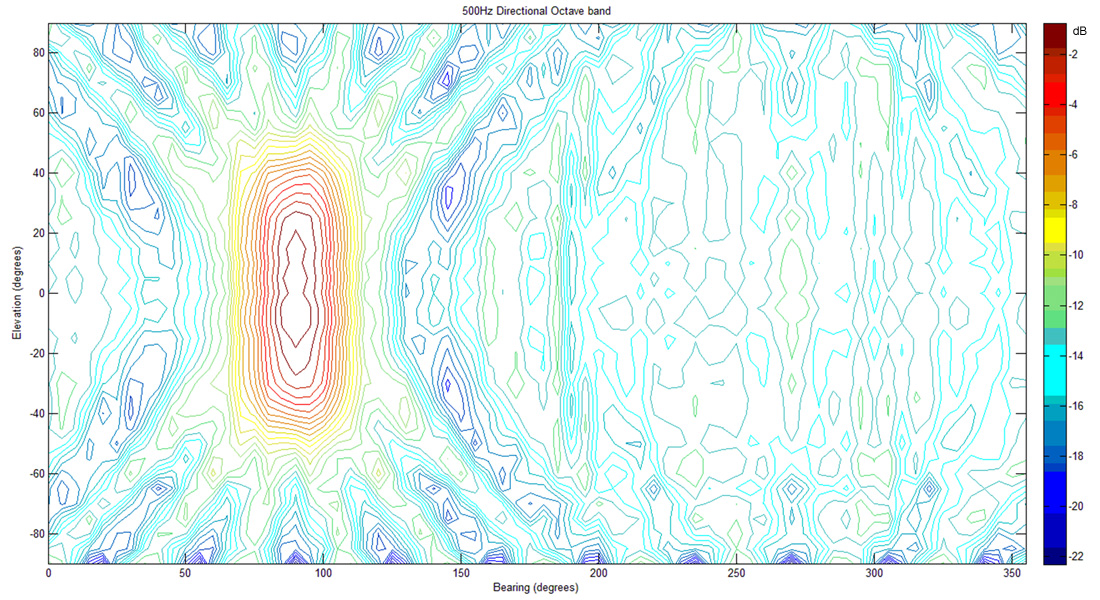 (The above image shows the beamforming attenuation heatmap in decibels for the 500Hz band with source at 90 degrees)
(The above image shows the beamforming attenuation heatmap in decibels for the 500Hz band with source at 90 degrees)
The beam processing algorithm also selectively attenuates signals which arrive outside the expected horizontal plane (+/-30 degrees). This ensures that events such as plane fly-bys are ignored from noise results.
"...utilises an automatic calibration system..."
The ENC utilises an automatic calibration system that is capable of detecting the application of a 1kHz test tone at a nominal 94dB to any of the 26 microphones in the array. On detection of the calibration tone, the ENC stores the updated calibration factors along with the following information:
- Serial number of the acoustic calibrator
- Date the calibration occurred
- Calibration report/certificate number of the acoustic calibrator
- Applied offsets
This feature allows for calibration of the ENC's microphone array to be fast and efficient and minimises the maintenance time required on site.
"...continuously performs fault diagnostics..."
The Environmental Noise Compass™ also performs continual fault diagnostics of the microphone array, allowing for individual damaged microphones to be isolated from beams and flagged for replacement.
In the event of a fault detection within the 26 microphone array, the ENC's fault diagnosis feature is capable of reporting which part of the array is damaged, whilst also excluding the at fault microphone(s) from the measurement and continue monitoring.
"...unaffected by temperature differences throughout a wide range..."
One of the benefits of the beam forming algorithm used within the Environmental Noise Compass™ is the ability to remain relatively unaffected by wide swings in environmental temperatures.
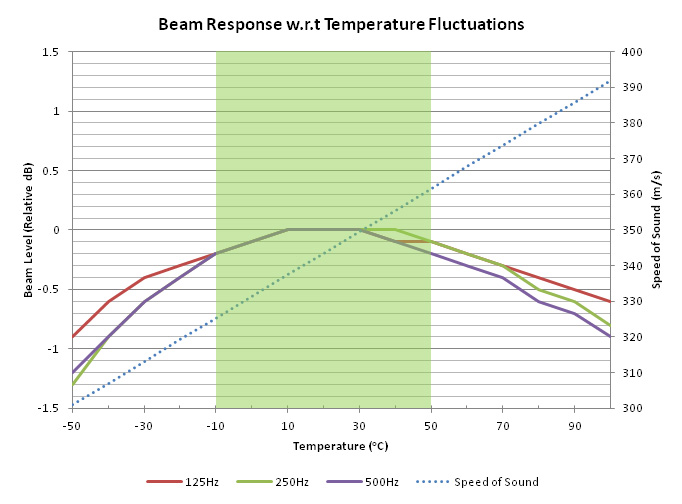 As is visible from the above temperature graph, the Environmental Noise Compass™ has a maximum deviation of 0.2dB between -10 to 50 degrees Celcius (Well within IEC 61672 Class 1 compliance) and has a maximum deviation of of 1.3dB in the broad-band temperature range from -50 to 100 degrees Celcius.
As is visible from the above temperature graph, the Environmental Noise Compass™ has a maximum deviation of 0.2dB between -10 to 50 degrees Celcius (Well within IEC 61672 Class 1 compliance) and has a maximum deviation of of 1.3dB in the broad-band temperature range from -50 to 100 degrees Celcius.
"...hold up to 3 months of statistical data..."
The data measured and processed by the Environmental Noise Compass™ is stored to an internal SQL compatible database. The database is kept on a local storage server that can hold up to 3 months (upgradeable) of statistical data along with an optional 7 days of compressed continuous omni and directional audio. The compressed audio files also include a stream of all short term Leq results (omni, octaves and directional results).
The ENC's storage server protects recorded data by utilising a mirrored array of storage drives, providing a high level of disk redundancy in the event of catastrophic failure. The storage server's database can also be extended over a wired or wireless LAN to allow multiple Environmental Noise Compass™ units to store data to a central location.
"...allows remote TCP-IP access..."
The Environmental Noise Compass™ accepts TCP-IP connections to allow users to retrieve status updates, audio streams and measured environmental/directional data. Remote access to the unit also allows new firmware versions to be automatically downloaded without the need to have personnel travel to the unit itself and install new software.
The Environmental Noise Compass™ also can be connected to a 3G cellular wireless network to allow for remote access in locations without fixed line internet.
System Dataflow

Optional Extras
Pneumatic Mast
The Environmental Noise Compass™ can be provided with an air-operated pneumatic mast as optional. The pneumatic mast allows for easy access to the highest parts of the array (eg. when calibration or microphone replacement is required) .
Noise Cloud™
New from Acoustic Research Labs, Noise Cloud™ is a cloud-based noise and data logging service that allows sound level meters and noise loggers to stream data to a Noise Cloud™ online account for users to view and download data from any or all linked devices.
The Environmental Noise Compass™ can stream data to a Noise Cloud™ account allowing for a simple online user interface to view ENC data and results.

Find out more about Noise Cloud™ here
Applicable Standards:
- IEC 61672-1:2013 Class 1
- AS1259.1/.2:1990 Type 1
- AS/NZS 4476:1997 Class 1
- IEC 60651 Type 1
- IEC 60804 Type 1

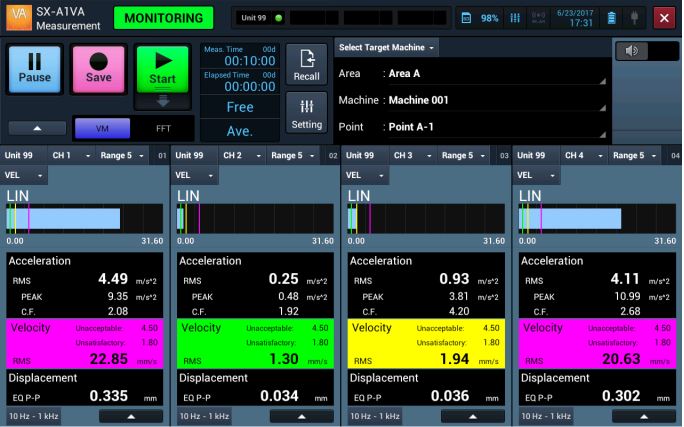
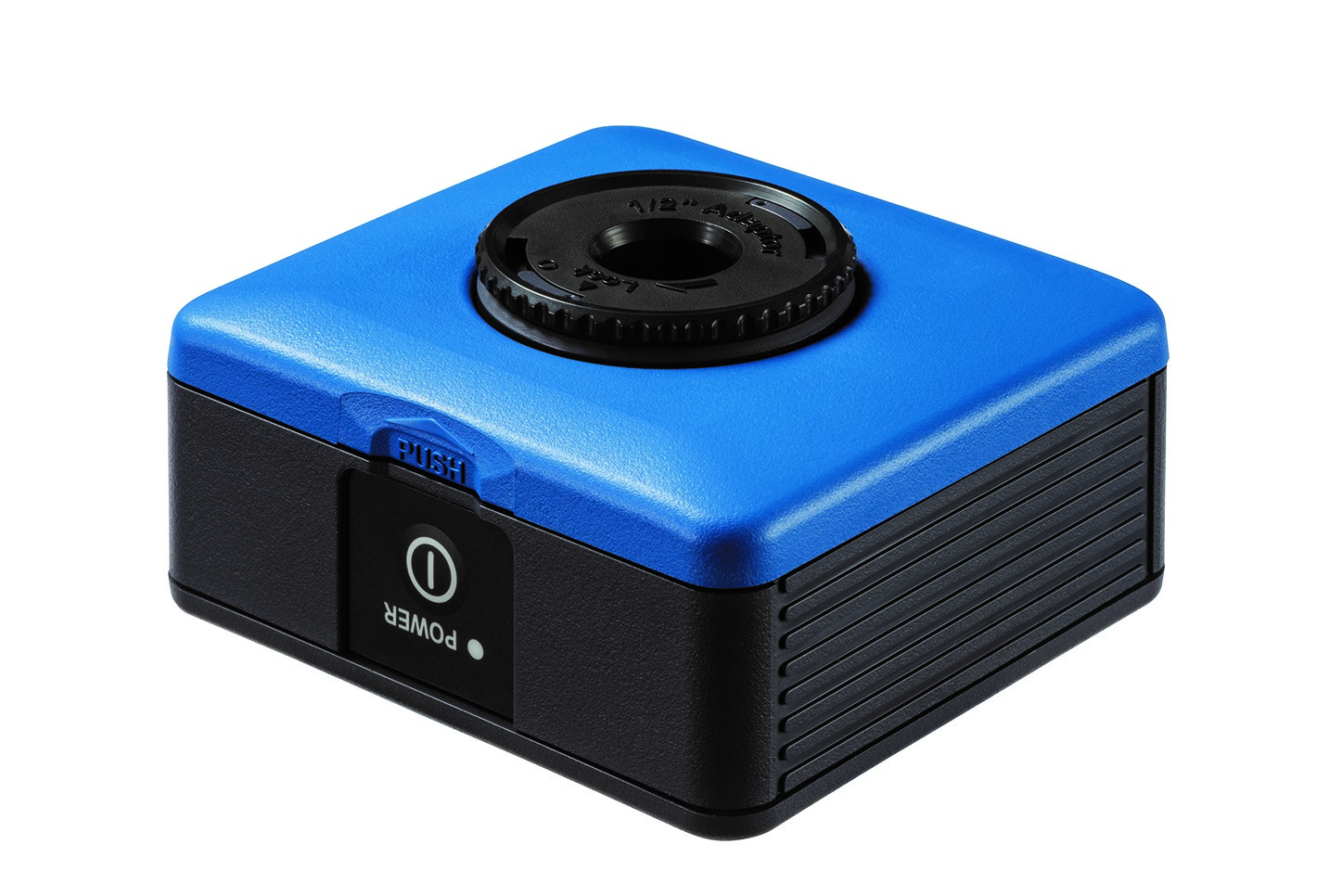


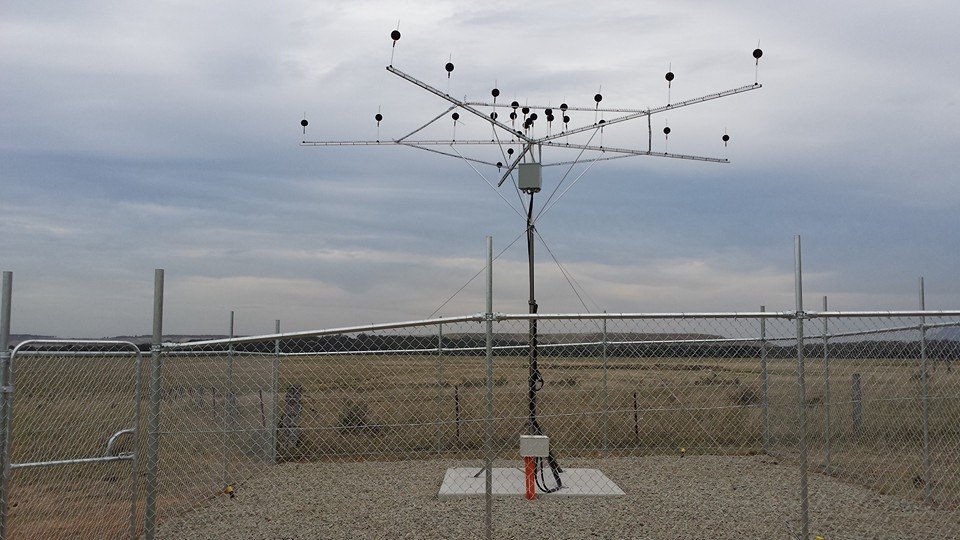
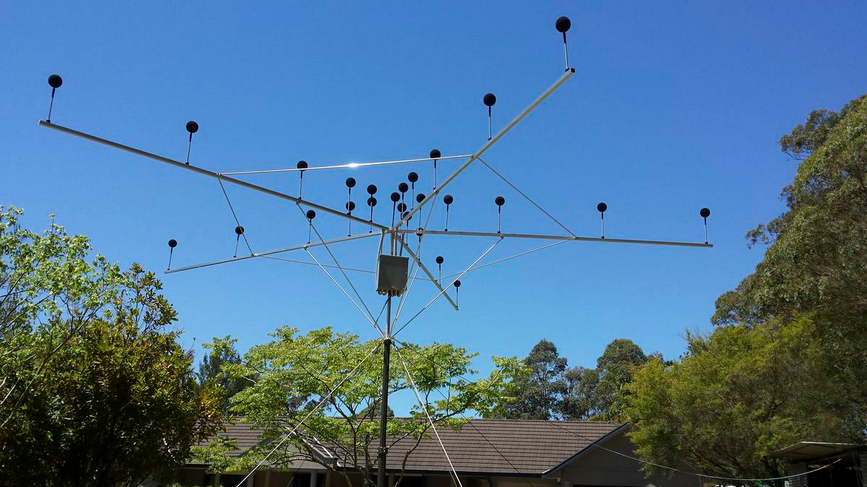
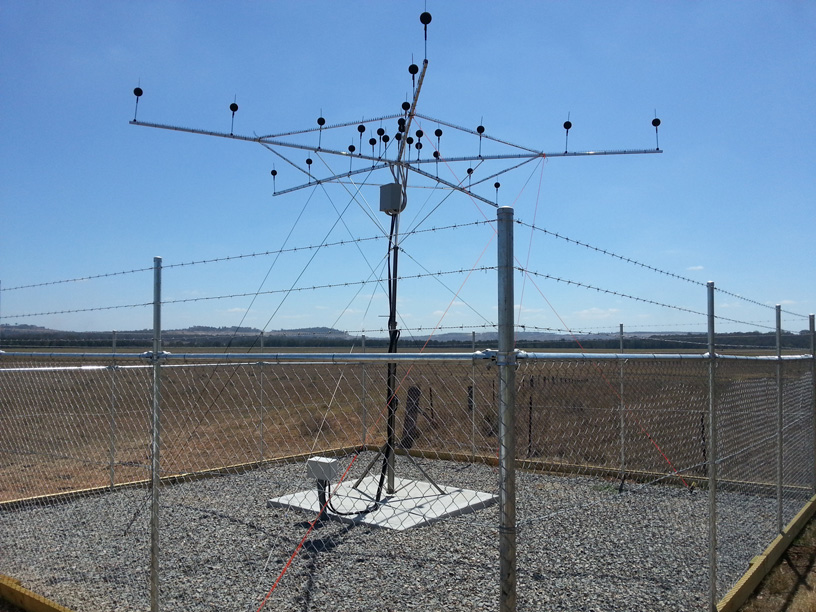


 As is visible from the above temperature graph, the Environmental Noise Compass™ has a maximum deviation of 0.2dB between -10 to 50 degrees Celcius (Well within IEC 61672 Class 1 compliance) and has a maximum deviation of of 1.3dB in the broad-band temperature range from -50 to 100 degrees Celcius.
As is visible from the above temperature graph, the Environmental Noise Compass™ has a maximum deviation of 0.2dB between -10 to 50 degrees Celcius (Well within IEC 61672 Class 1 compliance) and has a maximum deviation of of 1.3dB in the broad-band temperature range from -50 to 100 degrees Celcius.